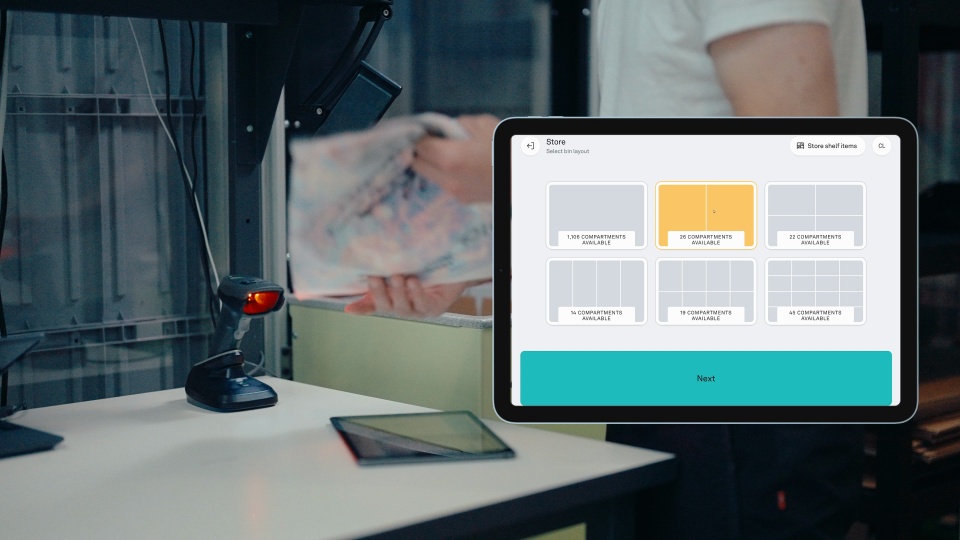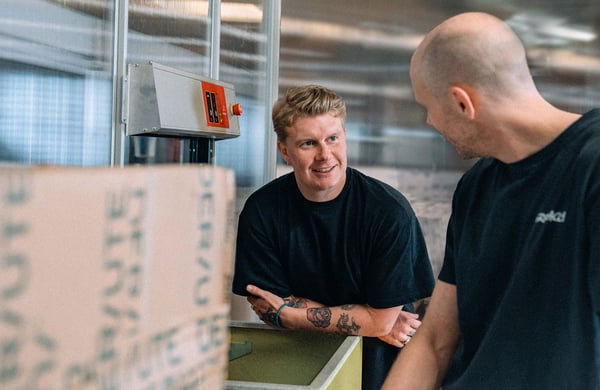Does a Pio system make sense for warehouses that handle recurring bulk orders? And what about warehouses that handle both B2B and B2C orders? Can Pio support both?
The answer to these questions is: yes. So if you’re in the business of B2B, then pay attention. Pio’s unrivaled efficiency and accuracy have the potential to change the game for your warehouse operations, from inventory management to order fulfillment.
For Those Who Are New Here: What is Pio?
Pio is a cube-based automated warehouse system that replaces the aisles and shelving of a traditional warehouse with an ultra-compact grid that stores up to 10x more goods in the same space. Robots run along the top of the grid to access the bins that hold inventory, bringing them to ports for order picking. All workers need to do is to open the Pio app, select an open order, and pick products as bins arrive at the port.
Now, let’s get into how Pio works for B2B warehouses.
Features and Processes
1. Multiple ports.
A Pio system can be designed with multiple ports to best suit a B2B warehouse’s needs. If inbound and fulfillment are happening in tandem, you can designate one port for storing, and another port for order picking. Or, if you need to increase the rate of picking for a bulk order, you can designate all ports to be used for picking. When you’re dealing with a large influx of goods, you can designate multiple ports to the storage of new inventory until you’re ready to start picking orders again.
2. Filtered orders.
Warehouses that juggle both B2B and B2C can filter orders in the Pio app, so that workers can keep workflows separate. Pio’s multiple ports also let you fulfill B2B and B2C orders simultaneously by designating one for each workflow.
3. Bin prepping.
B2B orders call for larger numbers of both order lines and units per order line. As B2B orders come in, the robots prep the bins as part of the usual backlog of orders, lined up at the ready until it’s time to pick. This means if your warehouse also handles B2C, you can choose the most convenient time to pick and pack a larger B2B order.
4. Pause picking.
You can also “pause” picking an order, while the system keeps track of how much of the order is still unfulfilled. This allows you to efficiently switch between B2C and B2B order fulfillment. With Pio, a worker can start picking a large B2B order from one port, pause the order, and begin picking smaller B2C orders.
5. Store multiple brands in one system.
You can store various product groups or brands in a single system, organized by the Pio app. For instance, our customer Blender Agency comprises an entire family of brands, and they store all their distinct offerings in their Pio system without needing to separate them into different warehouse zones.
6. Inbound ease.
Inbound processes are streamlined, as you’re often able to store entire boxes of products in a single Pio bin, and simply update the quantity in the app.
7. Shelf picking.
For large items or bulk stock, you can use shelves. The Pio app will add the shelf locations to the order flow and direct workers there as needed.
8. Accessible pricing.
Our pricing model charges a flat fee per robot, so the cost is the same no matter how many orders you pick and how much the robots are used. It’s also easy to scale up or down your Pio system, adding and removing robots to meet changing business needs.
9. Speed and efficiency.
The speed and efficiency of the Pio system provides a massive boost for B2B fulfillment, with a minimum of 130 order lines/hour picked and packed per person. It’s far quicker than picking and packing orders with a manual system, even one that’s using batch picking.
10. Space-smart design.
The incredibly compact design means you can fit up to 10x more inventory in your existing space, leveling up the quantity of B2B orders your warehouse can accommodate.
In Conclusion...
The Pio system can flex for the specific processes of B2B warehouses, including picking, packing, shipping, and inventory management. Unparalleled speed and accuracy, plus 10x increased storage capacity—it all adds up to significantly reduce your costs, from energy to labor.
This decrease in spending guarantees a swift return on investment to benefit your business for years to come. To learn more about Pio and explore whether this solution is right for your B2B warehouse, contact us. We’d love to tell you more.





.jpg?width=600&name=Beauty-Welness-Pio-04743%20(1).jpg)